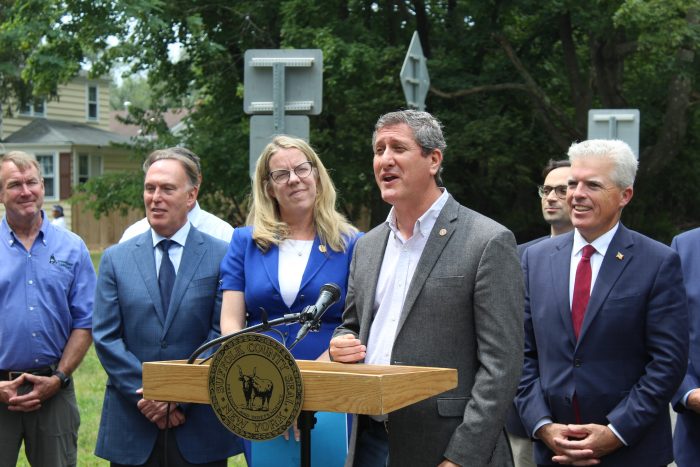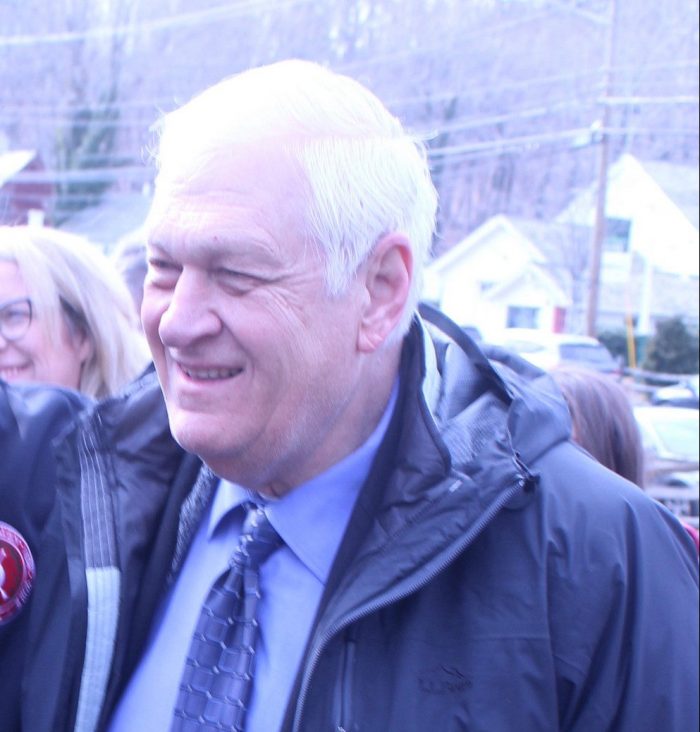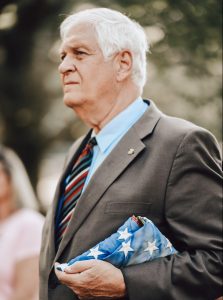On the road to community revitalization, Port Jefferson Station/Terryville just passed a major procedural hurdle.
Public officials gathered along the eastern trailhead of the Setauket-Port Jefferson Station Greenway Trail on Friday, Aug. 11, announcing $5 million to create sewer plans for the Route 112 corridor. These funds, which come from the American Rescue Plan Act, will help lay the groundwork for an eventual expenditure to finance the entire sewer project.
“What we’re talking about is the objective of achieving economic revitalization, job creation, business growth and water quality protection all at the same time,” said Suffolk County Executive Steve Bellone (D).
Bellone said there are several potential funding sources from the federal and state governments, but those levels require “shovel-ready plans.” This $5 million, Bellone continued, would maximize the potential for a full-scale sewer investment.
“You never know when all of a sudden at the federal level or the state level funding becomes available,” he said. “It can happen like that, and you need to be ready,” adding, “This funding will help get this sewer project shovel ready.”
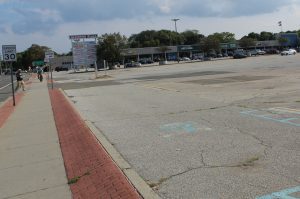
Local revitalization
The sewer investment comes on the heels of a decades-long local effort to bring about a traditional downtown in PJS/T.
Major development plans are currently on the drawing board, most notably the proposed $100 million redevelopment of Jefferson Plaza, located just south of the Greenway. Former Suffolk County Legislator Kara Hahn (D-Setauket) [See story on Hahn’s recent resignation] said the $5 million would bring community members closer to realizing their local aspirations.‘Port Jefferson Station is on the rise.’
— Jonathan Kornreich
“The synergy here between doing something that will drive economic prosperity as well as a cleaner environment is a win-win, and sewering will become the foundation on which the Port Jefferson Station hub will be built,” Hahn said. “This is a tremendous step forward.”
Town of Brookhaven Councilmember Jonathan Kornreich (D-Stony Brook), who represents Port Jefferson Station/Terryville on the Town Board, cited ongoing revitalization efforts as a means to promote and enhance the quality of life for the hamlet’s residents.
“Speaking directly to the members of our community, I think you should be encouraged by the fact that from the federal government all the way down to the town level, our eyes are on you,” he said. “There are hundreds of millions of dollars of investment — both public and private money — planned, already made, on the table and in the books for this immediate surrounding area.”
The councilmember added, “Port Jefferson Station is on the rise.”
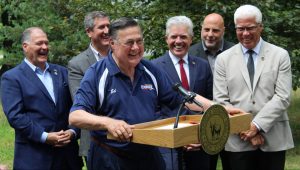
Brookhaven Town Supervisor Ed Romaine (R), who is running for Suffolk County executive against business leader Dave Callone, a Democrat, tied the sewer investment to plans for commercial redevelopment and water quality protection.
“We are looking to redevelop Port Jeff Station,” Romaine said. “Sewers are necessary for development.” The town supervisor added, “I look with great anticipation for this and any other sources of funding that we can put in place to make sure that we can preserve our surface and groundwater. It’s key.”
Density/traffic
The introduction of sewers into Port Jefferson Station raises several questions about potentially added building density enabled through increased sewer capacity.
New leadership within the Port Jefferson Station/Terryville Civic Association has recently prioritized density, creating a land use committee to oversee new developments throughout the hamlet.
Reached by phone, civic president Ira Costell called the sewer project “the fundamental building block to protect water quality,” though calling the initiative “a positive step that has to be done carefully.”
“While the sense of our organization is that we welcome redevelopment and positive growth, we are mindful of ensuring this occurs in a well-planned and strategic way that benefits the community and ameliorates impacts,” Costell said
“There are still some concerns about the overall density and intensity of use in the Port Jeff Station area, and we’re just hopeful that the planning process will enable the community to have proper input,” he added.
Paul Sagliocca, a member of the civic, advocated for some money to be set aside to evaluate potential traffic impacts from new developments along 112.
“This downtown revitalization is great, but it needs to stay on the main roads,” he said. “They need to do a comprehensive traffic study.”
Kornreich noted that the commercial real estate landscape has shifted dramatically following the COVID-19 pandemic.
“Downtowns … are seeing high rates of vacancy, commercial spaces that are underutilized, subprime kinds of tenants because landlords are desperate to get any kind of cash flow in there,” the Brookhaven councilmember said. “We have to take some action to rezone and repurpose some of this underutilized real estate.”
He pointed to mixed use as a possible solution, noting the simultaneous need to resolve housing shortages and repurpose commercial real estate.
Mixed-use development “creates walkable areas that can be sewered, that are more environmentally friendly and are more economically viable,” he added.
Bellone expressed confidence in the local planning process. “There has been a lot of community-based work that has been done at the town level, the community level and in partnership with the county,” the county executive said. “That process, I know, will continue.”
Sewer debate
The announcement follows an ongoing public debate about the regional viability of sewers in Suffolk County. Just last month, the Republican-led Suffolk County Legislature rejected the administration’s proposal to put a 1/8 penny sales tax on the upcoming November ballot to finance new wastewater infrastructure. [See story, “Suffolk County Legislature recesses, blocks referendum on wastewater fund,” July 28, TBR News Media website.]
Deputy County Executive Peter Scully, who had spearheaded the sales tax initiative, attended Friday’s press event and maintained that the need for sewers remains. He commended the county Legislature for approving a long-term sewer infrastructure plan in 2020.
“This sewer project in Port Jefferson Station’s commercial hub is part of that plan,” he said.
New York State Sen. Mario Materra (R-St. James), whose 2nd District previously encompassed Port Jeff Station before last year’s redistricting process, attended the press event.
The state senator said this $5 million would signal to higher levels of government the area’s willingness to modernize its wastewater infrastructure and support the environment.
“We have a $4.2 billion bond act” approved by New York state voters last November, Mattera noted. “Jobs like this will show [officials] up in Albany to bring us the money back and that we really are serious about sewering and we care about our clean water.”

